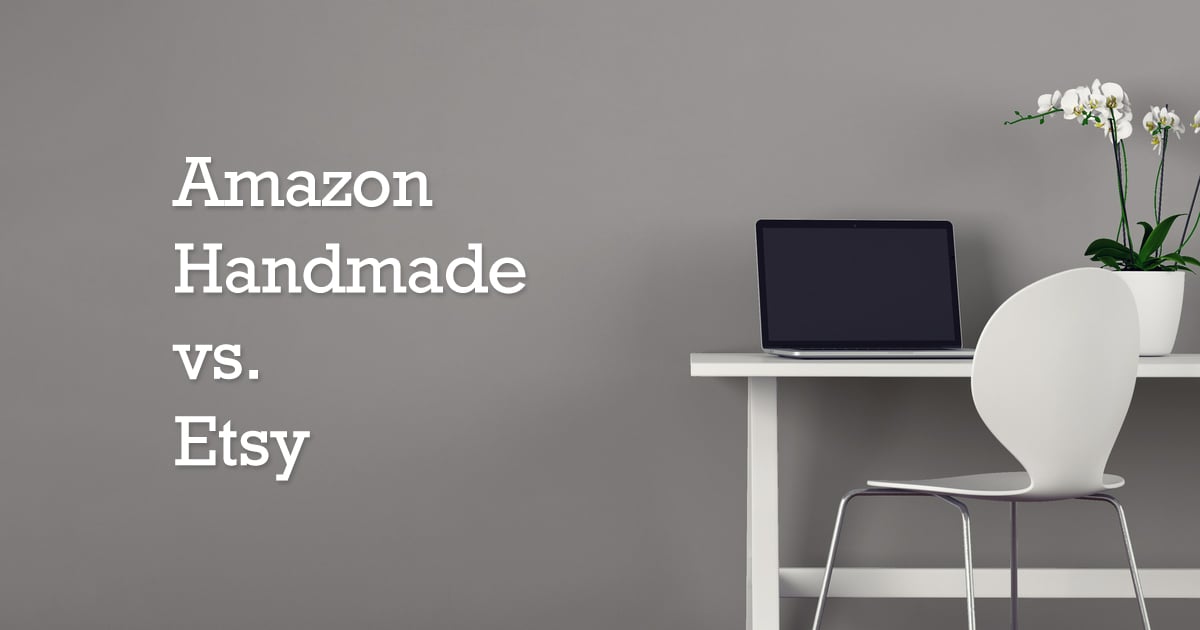Should you move your Etsy store to Amazon Handmade?

The internet is full of online marketplaces for you to sell your wares. But is there a clear leader for handmade products specifically?
Below, we zero in on which platform is better for handmade sellers, Etsy or its contender, Amazon Handmade.
About Etsy: A Well-Known Artisanal Marketplace
Etsy first launched its specialized online marketplace in 2005, a site dedicated to the sale of handmade and vintage goods. More than 15 years later, the company still dominates the market. It has earned a reputation as the champion of the little guy.
Small business owners, artisans, vintage dealers, and craftsmen flock to list their unique and enchanting goods on the site. According to their declared mission and values:
"In an Etsy Economy, creative entrepreneurs can find meaningful work selling their goods in both global and local markets, where thoughtful consumers can discover those goods and build relationships with the people who make and sell them."
About Amazon Handmade: A Formidable Challenger
Amazon Handmade launched in 2015. The handmade marketplace gave sellers unprecedented access to Amazon's thriving market. Compared to Etsy's audience, the opportunities for exposure seemed endless.
Plus, Amazon Handmade promised that a strict seller application process would mean fewer sellers and less competition.
Five years later, is Amazon Handmade the answer handmade sellers were looking for?
Amazon Handmade: The Pros
High-Traffic Exposure
Amazon is known to attract up to 300 million customers, blowing other online marketplaces out of the water. While the Handmade category isn't as well-known, a significant volume of users are drawn to its 650,000 product offerings.
The exposure is the biggest advantage available to artisans who want to leverage the Handmade platform.
Fulfillment by Amazon
Amazon offers a service called Fulfillment by Amazon (FBA): "Let Amazon pick, pack, and ship your orders." For handmade sellers who don't make customized products per order, would rather not store products in their garage, and don't want to deal with order fulfillment on a day-to-day basis, this service could be a dream come true.
Custom Product Abilities
Like Etsy, Amazon Handmade gives you the ability to offer personalized products. Use dropdowns, text, or number input fields and custom pricing to create your listings in the same bespoke fashion.
Amazon Handmade: The Cons
High seller fees, limited product categories, and the same strict seller application that once seemed promising are just a few reasons why the marketplace may not best serve the needs of the artisanal community.
Enormous Fees
Amazon Handmade seller fees are at least twice as much as Etsy's. Amazon Handmade charges a 15% commission and $39.99/month (for artisans selling more than 40 items).
Etsy's charges, on the other hand, are only $0.20/item to list with a 5% commission cut. Many artisans have found that Amazon's fees are simply too steep for them to hold up.
Insufficient Categories
Products that don't fit into one of Amazon's narrowly defined categories are not allowed on Amazon Handmade. To make matters worse, there are only 14 product categories listed as of March 2020 (full list below) ... Etsy has 160.
- Accessories
- Artwork
- Baby
- Beauty & Personal Care
- Clothing
- Shoes & Handbags
- Home
- Outdoor & Home Care
- Jewelry & Watches
- Kitchen & Dining
- Pet Supplies
- Sporting Goods
- Stationery & Party Supplies
- Toys & Games
Slow Application Process
Not everyone gets approved, which is fine if it weeds out competition and low-quality sellers. But all it seems to be doing is delaying reputable sellers from getting started. Your application could be pending for weeks or even months.
This can been seen as a turn-off when other sites allow you to get started right away.
Commoditization Culture
Amazon is known for being fast and cheap. This is essentially the opposite of the handmade artisan movement.
While the cheapest price often wins the customer with commodity goods, handmade goods are intended to be unique, revered, and cared for. You want your customer to see you as a valuable brand or a human behind the product, rather than a commodity that can be switched out willy-nilly.
Brand Erosion
You have no chance to create a recognizable brand on Handmade. Brands are restricted from including any marketing or promotional materials in shipping boxes for orders purchased from Amazon. This means you can't create a memorable unboxing experience or put care into how you package your products.
Customer Control
Amazon owns your customer, not you. You'll have no access to customer data, no ability to direct them to your website, and no email address to remarket to. Giving up that much control in your marketing and brand building may not be worth it if you're looking to build long-term customers.
Delayed Payment
Amazon's payment structure mirrors their commoditization culture – Amazon releases payment for goods as soon as products are shipped.
Etsy, on the other hand, releases payment as soon as the consumer has purchased. This gives vendors the opportunity to use payment for supplies, if needed. There's an understanding that the artisan may make a product to order, whereas Amazon artisans are still expected to churn out product.
Nonexistent Storefront Organization
There's no way to sub-categorize or group your product listings. Take it from DearHandmadeLife:
"...Your shop will sort of be a free-for-all with your most popular products showing up first, (or you can select four of your favorites manually) and the rest will be displayed as the customer chooses by popularity, price, customer reviews, or most recent. It can be hard to browse all your items if you have a large catalog like mine..."
Rigid Seller Standards
Your ratings aren't just for customers – if your numbers drop below a certain threshold, Amazon Handmade can penalize you. Customer service is important, but this high threshold for success can be a burden to maintain.
The Verdict: Is Amazon Handmade Worth It?
Artisans Should Be Cautious About Amazon Handmade
While many small business owners and artisans were excited to dive into Amazon Handmade when it first launched in 2015, many have since retreated. Most concluded that the high fees, brand erosion, and commoditization culture simply didn't align with their values, or support their goals.
Now when searching the internet for advice on Amazon Handmade, you'll mostly find warnings to stay away.
Sell On Amazon Handmade In Addition To Etsy If ...
There are a few, however, who make Amazon Handmade work. Or, perhaps, Amazon Handmade works for them.
Some follow the philosophy to get on "as many platforms as possible, just so you can get as many views as you can." Others prefer not to maintain as many personal connections with customers as is encouraged by Etsy. Then, there are the lucky vendors who sustain enough volume from Handmade to withstand the higher fees, even without building their brand.
Essentially, if you starting out small as a solopreneur in the handmade space, you'll probably want to steer clear of Amazon Handmade. Start with Etsy.
If you're big enough that you're pumping out products at Amazon capacity, go for it! It may be just the boost you need. This is especially true for dropshippers and white labelers who don't have a time-intensive production process or aren't working with limited run sizes.
Ready to start selling? OnlineLabels.com offers the label sizes needed to get your shop up and running. From Amazon FBA labels and Etsy shipping labels to high-quality product labels and inventory labels, you're sure to find exactly what you need to get the job done.
Looking for more helpful resources? Check out our articles on Fulfillment by Amazon and FBA Labeling.
We also offer tons of content to help Etsy sellers, including Etsy marketing tips and interviews with an Etsy beauty brand, Etsy soap seller, and Etsy candle entrepreneur.
This article is meant to be used as a guide, not as an authoritative resource. At the time of publication (October 2019), the information mentioned above is compliant with Amazon and Etsy's policies and pricing structures. We are not responsible or liable for any actions taken as a result of using the content or resources listed above.
OnlineLabels.com is not affiliated with Amazon or Etsy. Neither Amazon nor Etsy sponsors or endorses any article or products sold by OnlineLabels.com.


